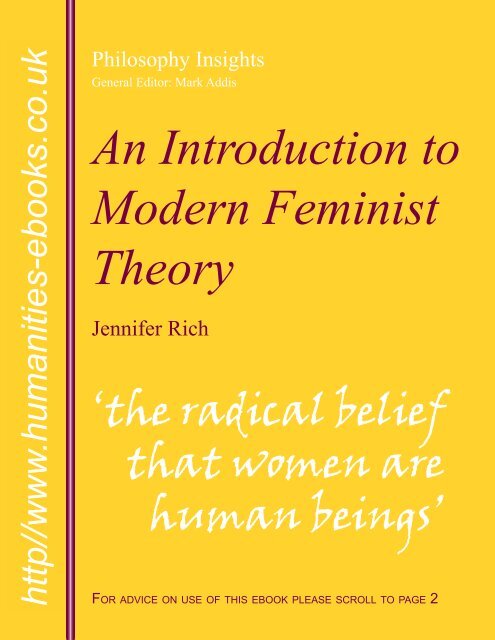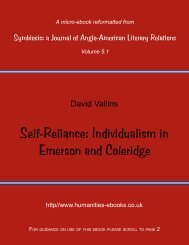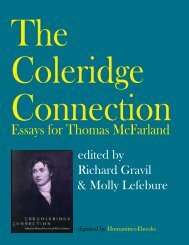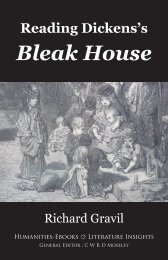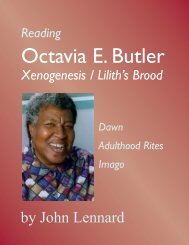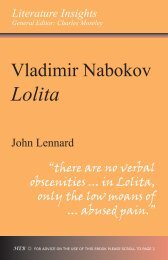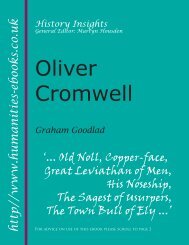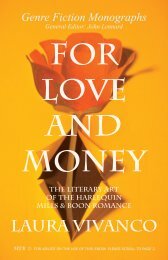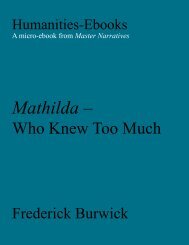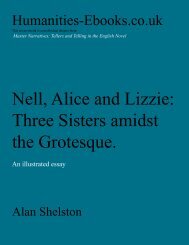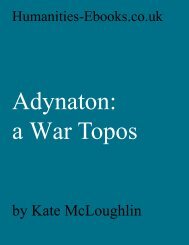An Introduction to Modern Feminist Theory - Humanities-Ebooks
An Introduction to Modern Feminist Theory - Humanities-Ebooks
An Introduction to Modern Feminist Theory - Humanities-Ebooks
Create successful ePaper yourself
Turn your PDF publications into a flip-book with our unique Google optimized e-Paper software.
Running Head <br />
http//www.humanities-ebooks.co.uk<br />
Philosophy Insights<br />
General Edi<strong>to</strong>r: Mark Addis<br />
<strong>An</strong> <strong>Introduction</strong> <strong>to</strong><br />
<strong>Modern</strong> <strong>Feminist</strong><br />
<strong>Theory</strong><br />
Jennifer Rich<br />
‘the radical belief<br />
that women are<br />
human beings’<br />
For advice on use of this ebook please scroll <strong>to</strong> page 2
Publication Data<br />
© Jennifer Rich, 2007<br />
The Author has asserted her right <strong>to</strong> be identified as the author of this Work<br />
in accordance with the Copyright, Designs and Patents Act 1988.<br />
Published by <strong>Humanities</strong>-<strong>Ebooks</strong>.co.uk<br />
Tirril Hall, Tirril, Penrith CA10 2JE<br />
Reading Options<br />
* Please adjust the magnification <strong>to</strong> 82% and progress by using the page<br />
forward / back but<strong>to</strong>ns (<strong>to</strong> enlarge text further, select full screen: CTRL+L).<br />
* To navigate through the contents use the hyperlinked ‘Bookmarks’ at<br />
the left of the screen.<br />
* To search, click the search symbol and select ‘show all results’.<br />
* Hyperlinks, if any, are enabled for PC users only.<br />
* For the convenience of Mac users, any internal hyperlinks are also<br />
bookmarked, along with chapters and appendices.<br />
* To return from visiting an internal hyperlink or appendix please use the<br />
green ‘previous view’ but<strong>to</strong>n <strong>to</strong> return <strong>to</strong> your starting point.<br />
Licence and permissions<br />
This book is licensed for a particular computer or computers. The file itself<br />
may be copied, but the copy will not open until the new user obtains a licence<br />
from the <strong>Humanities</strong>-<strong>Ebooks</strong> website in the usual manner. The original purchaser<br />
may license the same work for a second computer by applying <strong>to</strong><br />
support@humanities-ebooks.co.uk with proof of purchase. Permissions: it is<br />
permissible <strong>to</strong> print one copy of this book (which must be done as one operation)<br />
but not <strong>to</strong> copy and paste text.<br />
ISBN 978-1-84760-023-3
<strong>An</strong> <strong>Introduction</strong> <strong>to</strong> <strong>Modern</strong> <strong>Feminist</strong><br />
<strong>Theory</strong><br />
Jennifer Rich<br />
Bibliographical Entry:<br />
Rich, Jennifer. <strong>An</strong> <strong>Introduction</strong> <strong>to</strong> <strong>Modern</strong> <strong>Feminist</strong> <strong>Theory</strong>. Philosophy Insights. Tirril:<br />
<strong>Humanities</strong>-<strong>Ebooks</strong>, 2007
Contents<br />
A Note on the Author<br />
<strong>Introduction</strong><br />
Initial Articulations of the ‘Woman’ Problem<br />
Virginia Woolf<br />
Simone de Beauvoir<br />
Radical Feminism<br />
Kate Millett<br />
Shulamith Fires<strong>to</strong>ne<br />
Radicalesbians<br />
Mary Daly<br />
Black Feminism<br />
Audre Lorde<br />
Alice Walker<br />
Patricia Hill Collins<br />
French Feminism<br />
Luce Irigaray<br />
Hélène Cixous<br />
Monique Wittig<br />
Julia Kristeva<br />
Materialist Feminism<br />
Gayle Rubin<br />
Gayatri Chakravorty Spivak<br />
Queer <strong>Theory</strong><br />
Adrienne Rich<br />
Judith Butler<br />
Eve Kosofsky Sedgwick<br />
Wayne Koestenbaum<br />
Bibliography<br />
Primary Sources<br />
Secondary Sources
A Note on the Author<br />
Jennifer A. Rich is an Assistant Professor of English at Hofstra University. Her published<br />
work includes essays on film, rhe<strong>to</strong>ric, Shakespeare and composition.<br />
She is also the author of <strong>An</strong> <strong>Introduction</strong> <strong>to</strong> Critical <strong>Theory</strong> in this series.
<strong>Introduction</strong><br />
At a cocktail party, a discussion of the definition of feminism was raging without<br />
a clear conclusion. Some participants suggested that feminism was the demand for<br />
‘equal rights’, some that it involved the dismantling of the ‘sex/gender’ system, still<br />
others that it was the unending struggle against male domination in all its forms.<br />
Finally, an eight-year-old who had been listening intently <strong>to</strong> the conversation disingenuously<br />
asked the following—‘isn’t feminism the belief that women are human<br />
beings’? At this question, all conversation s<strong>to</strong>pped; the eight-year-old boy had hit the<br />
nail on the head. All that was needed was a slight emendation of his interrogative—<br />
that is that feminism IS the radical belief that women are human beings.<br />
While this definition might seem painfully obvious, it nevertheless <strong>to</strong>uches on the<br />
trajec<strong>to</strong>ry of feminist theory of the last thirty years, what we will call ‘second-wave<br />
feminism’. All feminist theory has been concerned in divergent ways and through<br />
divergent means with establishing the ‘subject-position’ of women. To say that a<br />
woman is a human being is <strong>to</strong> disentangle her from the dangerous nexus of objectification,<br />
prejudice and cultural norms and it is, most importantly, <strong>to</strong> establish her on an<br />
equal footing with ‘men’ and all that this subject-position provides. The rehumanization<br />
of ‘woman’ is the goal of the feminist theoreticians that we will consider in this<br />
volume.
Initial Articulations of the ‘Woman’ Problem<br />
Virginia Woolf<br />
Virginia Woolf is perhaps best known as one of the twentieth-century’s most important<br />
modernist novelists. Until the 1970s, her novels were far more widely read than<br />
her feminist essays (and the novels still enjoy much deserved popularity); since the<br />
advent of second-wave feminism, however, her feminist works such a A Room of<br />
One’s Own and Three Guineas—have been reestablished as central reading for students<br />
of feminist theory. For the purposes of our discussion, we will consider A Room<br />
of One’s Own, a text that best articulates the materialist-based analysis of female<br />
oppression that will prove one of the most significant influences on feminist methodology<br />
of the second wave.<br />
A Room of One’s Own<br />
Written in 1928 for a lecture at Gir<strong>to</strong>n College, Cambridge, A Room of One’s Own<br />
is Woolf’s comprehensive answer <strong>to</strong> the ‘woman problem’: the accusation of female<br />
inferiority in the arts and elsewhere. Woolf was asked <strong>to</strong> talk <strong>to</strong> the female students at<br />
Gir<strong>to</strong>n College—the only college in the U.K. that in 1928 admitted women—about<br />
the issue of ‘women and fiction’. In her text, Woolf reconstructs the thinking process<br />
that leads <strong>to</strong> the pronouncement that serves both as the title of her talk and its main<br />
argument: in order <strong>to</strong> write fiction, a woman must have a room of her own and £500<br />
per year. Although seemingly obvious—of course in order <strong>to</strong> write fiction you need<br />
space and money—Woolf’s argument necessarily involves disputing age-old observations<br />
of women’s capabilities and also encompasses a profound materialist analysis<br />
of the condition of women’s existence—at Gir<strong>to</strong>n and elsewhere.<br />
In novelistic fashion, Woolf recreates for her audience the gradual step-by-step<br />
evolution of her thinking in the course of her text. Although an essay, Woolf departs<br />
from linear argumentation: she judges herself incapable of ‘fulfill[ing] … the first<br />
duty of a lecturer—<strong>to</strong> hand you after an hour’s discourse a nugget of pure truth <strong>to</strong><br />
wrap up between the pages of your notebooks and keep on the mantelpiece forever’
<strong>Modern</strong> <strong>Feminist</strong> <strong>Theory</strong> <br />
(3). The fact that the first word of A Room of One’s Own is ‘but’—an interruptive<br />
conjunction that usually indicates a shift in thinking—only prefigures Woolf’s refusal<br />
<strong>to</strong> engage in traditional so-called ‘rational’ discourse. This introduc<strong>to</strong>ry ‘but’ is no<br />
accident, but rather signals a departure from male-defined thinking practices, ones<br />
which proceed from ‘a’ <strong>to</strong> ‘b’ without any residue of the thinking process that underlies<br />
such an approach. Woolf’s method is consciously messy: she wills the reader <strong>to</strong><br />
experience with her her thinking process, and thus <strong>to</strong> be able more fully <strong>to</strong> appreciate<br />
the far-reaching implications of her seemingly facile conclusion (about the room and<br />
the money):<br />
I am going <strong>to</strong> do what I can <strong>to</strong> show you how I arrived at this opinion about<br />
the room and the money. I am going <strong>to</strong> develop in your presence as fully<br />
and freely as I can the train of thought that led me <strong>to</strong> think this. Perhaps if I<br />
lay bare the ideas, the prejudices, that lie behind this statement you fill find<br />
that they have some bearing upon women and some upon fiction. At any<br />
rate, when a subject is highly controversial—and any question about sex is<br />
that—one cannot hope <strong>to</strong> tell the truth. One can only show how one come <strong>to</strong><br />
hold whatever opinion one does hold. (4)<br />
As promised, Woolf starts with an account of her visit <strong>to</strong> ‘Oxbridge’—a fictional<br />
combination of Oxford and Cambridge She recounts sitting ‘at the bank of a river’,<br />
her head bowed down by the task before her’—that is, coming <strong>to</strong> a meaningful conclusion<br />
about the <strong>to</strong>pic of women and fiction. <strong>An</strong> idea eventually comes <strong>to</strong> her, and sends<br />
her on an agitated walk <strong>to</strong>wards a library <strong>to</strong> examine a manuscript. Unfortunately, her<br />
idea and her sojourn <strong>to</strong> the library is interrupted by a beadle—a security officer—who<br />
s<strong>to</strong>ps Woolf because she has committed the unpardonable sin of walking on the grass<br />
rather than the gravel. While seemingly insignificant, the Beadle interrupts her process<br />
of thought—it sends, as she says, her little thought in<strong>to</strong> ‘hiding’. In this way, the<br />
Beadle represents the strictures that prevent women from thinking in significant ways<br />
at all. Just as they can not walk on the grass, they cannot sign their names <strong>to</strong> their<br />
works; they are expected <strong>to</strong> take care of children, and so on.<br />
This anecdote is just one of the ways that Woolf demonstrates the materialist bases<br />
of women’s oppression, and most importantly, that this oppression is not a result of<br />
the natural order of things, but is the inevitable product of social relationships and<br />
access <strong>to</strong> wealth. The most persuasive example of this material inequity is Woolf’s<br />
discussion—humorously enough—of the differences between the food served at the<br />
Men’s college at Oxbridge and the women’s college.
<strong>Modern</strong> <strong>Feminist</strong> <strong>Theory</strong> <br />
While her discussion inspires hunger in the reader and in the writer (filet of soles,<br />
partridges, and a wonderful meringue are served) what is also inspires is a sense of<br />
‘the good life’—of material comfort and the psychological feelings of confidence and<br />
aptitude that come with such comforts:<br />
<strong>An</strong>d thus by degrees was lit, halfway down the spine, which is the seat of the<br />
soul, … the more profound subtle and subterranean glow, which is the rich<br />
yellow flame of rational intercourse. No need <strong>to</strong> hurry. No need <strong>to</strong> sparkle.<br />
No need <strong>to</strong> be anybody but oneself. We are all going <strong>to</strong> heaven and Vandyck <br />
is of the company … (Woolf 11)<br />
Woolf pairs the discussion of dinner at the men’s college with supper at the women’s<br />
college. She includes a similar description of the food served, and the differences<br />
between the two become depressingly apparent:<br />
Here was my soup. It was a plain gravy soup. There was nothing <strong>to</strong> stir the<br />
fancy in that. One could have seen through the transparent liquid any pattern<br />
that there might have been on the plate itself. But there was no pattern. The<br />
plate was plain. (Woolf 17)<br />
It soon becomes obvious that unlike the feelings of comfort and security inspired by<br />
the men’s college dinner, this supper would in no way inspire such feelings. Woolf<br />
describes the querulous and ‘dubious’ state of mind that is the inevitable result of dining<br />
on mut<strong>to</strong>n instead of partridge:<br />
One cannot think well, love well, sleep well, if one has not dined well. The<br />
lamp in the spine does not light on beef and prunes. We are all probably going<br />
<strong>to</strong> heaven, and Vandyck is, we hope, <strong>to</strong> meet us round the next corner—that<br />
is the dubious and qualifying state of mind that beef and prunes at the end of<br />
the day’s work breed between them. (Woolf 19)<br />
Woolf’s focus on food telescopes the clear material differences between the men’s<br />
and women’s college—differences which can not but result in significant psychological<br />
and social inequities both within and without the academy. In order <strong>to</strong> understand<br />
fully the character of women’s oppression, however, Woolf explores the his<strong>to</strong>ry of<br />
women’s lives and their relationship <strong>to</strong> material wealth.<br />
<strong>An</strong>thony Vandyck (1599–1641) was the royal portraitist in seventeenth-century England. He was<br />
thus associated with aris<strong>to</strong>cracy, comfort and privilege.


